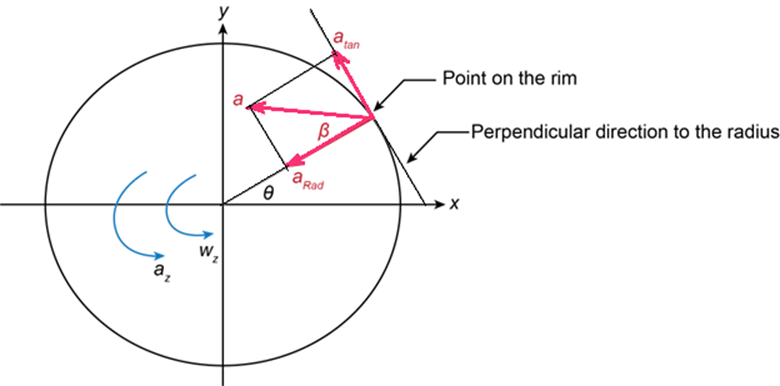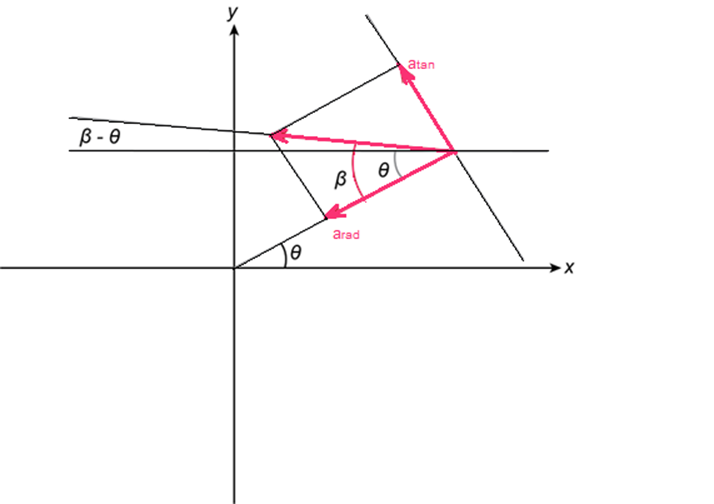Obtain the constant angular acceleration as follows:
\(\begin{aligned}{w_z} = \frac{{d\theta }}{{dt}}\\ = 1.10 + 12.60t\end{aligned}\)
\(\begin{aligned}{w_z}\left( {0.240} \right) = 1.10 + 12.60\left( {0.240} \right)\\ = 4.1{\rm{24 }}\frac{{{\rm{rad}}}}{{\rm{s}}}\end{aligned}\)
The constant angular acceleration is as follows:
\(\begin{aligned}{\alpha _z} = \frac{{d{w_z}}}{{dt}}\\ = 12.{\rm{60 }}\frac{{{\rm{rad}}}}{{{{\rm{s}}^{\rm{2}}}}}\,\,\,\left( {{\mathop{\rm constant}\nolimits} \,\,\,{\mathop{\rm angular}\nolimits} \,\,{\mathop{\rm acceleration}\nolimits} } \right)\end{aligned}\)
Obtain the radial acceleration of a point on the rim of the disk at the instant as follows:
\(\begin{aligned}{a_{Rad}} = w_z^2R\\ = {\left( {4.124} \right)^2}\left( {0.400} \right)\\ = 6.{\rm{803 }}\frac{{\rm{m}}}{{{{\rm{s}}^{\rm{2}}}}}\end{aligned}\)
Obtain the tangential acceleration of a point on the rim of the disk at that instant is as follows:
\(\begin{aligned}{a_{\tan }} = {\alpha _z}R\\ = \left( {12.60} \right)\left( {0.400} \right)\\ = 5.{\rm{040 }}\frac{{\rm{m}}}{{{{\rm{s}}^{\rm{2}}}}}\end{aligned}\)
Determine the magnitude of the resultant linear acceleration of a point on the rim of the disk at that instant as follows:
\(\begin{aligned}a = \sqrt {{a_{Rad}}^2 + {a_{\tan }}^2} \\ = \sqrt {{{\left( {6.803} \right)}^2} + {{\left( {5.040} \right)}^2}} \\ = \sqrt {71.682402} \\ = 8.{\rm{467 }}\frac{{\rm{m}}}{{{{\rm{s}}^{\rm{2}}}}}\end{aligned}\)

\(\begin{aligned}\beta = {\tan ^{ - 1}}\left( {\frac{{{a_{\tan }}}}{{{a_{Rad}}}}} \right)\\ = {\tan ^{ - 1}}\left( {\frac{{5.040}}{{6.803}}} \right)\\ = 36.5^\circ \end{aligned}\)
It is observed that \(0.10{\rm{0 rev}}\left( {\frac{{360^\circ }}{{1\,\,{\rm{rev}}}}} \right) = 36.0^\circ \) and that at \(t = 0 \to {\theta _0} = 0\,\,{\rm{rad}}\) \(\left( {{\mathop{\rm plug}\nolimits} \,\,\,t = 0{\mathop{\rm into}\nolimits} \,\,\theta \left( t \right)} \right)\).

\(\begin{aligned}\beta - \theta = 36.5^\circ - 36.0^\circ \\ = 0.5^\circ \end{aligned}\)
Hence, the linear acceleration of the point of the rim if \(\theta = 0.1{\rm{00 rev}}\) would be \(8.{\rm{467 }}\frac{{\rm{m}}}{{{{\rm{s}}^{\rm{2}}}}}\) over the direction \(0.5^\circ \) from the negative x-axis.





